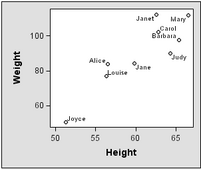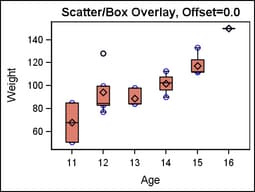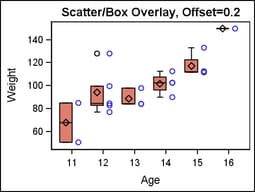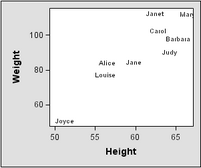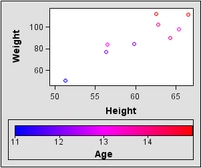Example Program and Statement Details
Example Program
proc template;
define statgraph scatterplot;
begingraph;
entrytitle "Height and Weight by Sex";
layout overlay;
scatterplot x=height y=weight /
group=sex name="scatter" datalabel=name;
discretelegend "scatter";
endlayout;
endgraph;
end;
run;
proc sgrender data=sashelp.class template=scatterplot;
run;
Options
specifies a style element
to be used with the MARKERCOLORGRADIENT= option.
| STARTCOLOR | color for the smallest data value of the column that is specified on the MARKERCOLORGRADIENT= option |
| NEUTRALCOLOR | color for the midpoint of the range of the column that is specified on the MARKERCOLORGRADIENT= option |
| ENDCOLOR | color for the highest data value of the column that is specified on the MARKERCOLORGRADIENT= option |
Interaction: For this option to take effect, the MARKERCOLORGRADIENT= option
must also be specified.
The REVERSECOLORMODEL= option can be used to reverse the
start and end colors of the ramp assigned to the color model.
specifies a column
for marker labels. The label positions are adjusted to prevent them
from overlapping.
Interaction: If a numeric column is specified
and the column has no format, a BEST6. format is applied.
Interaction: This option is ignored if the MARKERCHARACTER= option is used, which displays labels
instead of the markers.
specifies the color
and font attributes of the data labels. See General Syntax for Attribute Options for the syntax
on using a style-element and Text Options for available text-options.
specifies an amount
to offset all markers from X values for a discrete X axis, or from
Y values for a discrete Y axis. If both axes are discrete, the offset
applies to both axes.
Default: 0 (no offset, all markers are centered on the X values for a discrete
X axis, or on the Y values for a discrete Y axis)
Range: -0.5 to +0.5, where .5 represents half the distance between discrete
ticks. A positive offset is to the right on discrete X values and
up on discrete Y values. If the layout’s axis options set REVERSE=TRUE,
the offset direction is also reversed.
Details: This feature is useful for graphing multiple response variables
side by side on a common axis. By default within an overlay-type layout,
if a SCATTERPLOT is used with other plots with a discrete axis, the
markers are centered on the discrete X values, or discrete Y values,
or both. Depending on the data, the markers might be superimposed
over other graph data. The following code fragment shows the default
positioning when a SCATTERPLOT is used with a BOXPLOT:
layout overlay / cycleattrs=true
xaxisopts=(type=discrete);
scatterplot x=age y=weight;
boxplot x=age y=weight;
endlayout;
specifies the attributes
of the error bars that are associated with the data points. See General Syntax for Attribute Options for the syntax
on using a style-element and Line Options for available line-options.
Interaction: For this option to take effect, error bars must be displayed by
the XERRORLOWER=, XERRORUPPER=, YERRORLOWER=, or YERRORUPPER= options.
specifies a column
that indicates a frequency count for each observation of the input
data object. If n is the value
of the FREQ variable for a given observation, then that observation
is plotted n times.
creates a separate
marker type for each unique group value of the specified column.
Default: Each distinct group value might be represented in the graph by a
different combination of color and marker symbol. Markers vary according
to the ContrastColor and MarkerSymbol attributes of the GraphData1
- GraphDataN style elements.
Interaction: The group values are mapped in the order of the data, unless the INDEX= option is used to alter the default sequence
of markers and colors.
Interaction: If the MARKERCHARACTER= and MARKERCOLORGRADIENT= options are used, their settings
override the group settings for marker symbol and marker color.
Interaction: The representations that are used to identify the groups can be
overridden. For example, each distinct group value is represented
by a different marker symbol, but the MARKERATTRS= ( SYMBOL= marker ) option could be used to assign the same
symbol to all of the plot’s marker symbols, letting marker
color indicate group values. Likewise, MARKERATTRS= ( COLOR= color ) could be used to assign the same color
to all markers, letting marker symbol indicate group values.
specifies indices for
mapping marker attributes (color and symbol) to one of the GraphData1
- GranphDataN style elements.
Interaction: All of the indexes for a specific group value must be the same.
Otherwise, the results are unpredictable.
Interaction: If the MARKERCHARACTER= and MARKERCOLORGRADIENT= options are used, their settings
override the group settings for marker symbol and marker color.
Interaction: The index values are 1-based indices. For the style elements GraphData1
- GraphDataN, if the index value is greater than N, then a modulo
operation remaps that index value to a number less than N to determine
which style element to use.
Discussion: Indexing can be used to collapse the number of groups that are represented
in a graph. For more information, see Remapping Groups for Grouped Data.
specifies the attributes
of the data markers. See General Syntax for Attribute Options for the syntax
on using a style-element and Marker Options for available marker-options.
Interaction: If the MARKERCOLORGRADIENT= option is specified, this option’s
COLOR= setting is ignored.
specifies a column
that defines strings to be used instead of marker symbols.
Interaction: If the GROUP= option is also used, color is displayed
for a DISCRETE legend, but the character is not displayed in the legend.
If the GROUP= option
is also specified, the same colors are applied to the text strings
as would have been applied to markers.
specifies the color
and font attributes of the marker character specified on the MARKERCHARACTER= option. See General Syntax for Attribute Options for the syntax
on using a style-element and Text Options for available text-options.
When the GROUP= option is also specified, each distinct group
value might be represented by a different color (depending on the
ODS style setting or the setting on the INDEX= option). The marker character that is associated
with the group is assigned the group color. This option’s COLOR=
suboption can be used to specify a single color for all marker characters
in a graph, without affecting items that have the group color, such
as error bars and marker symbols.
specifies the column
that is used to map marker colors to a continuous gradient.
Restriction: To display a legend with this option in effect, you must use a CONTINUOUSLEGEND
statement, not a DISCRETELEGEND statement.
Interaction: This option overrides the COLOR= setting of the MARKERATTRS= or MARKERCHARACTERATTRS= option.
This option can be
used to add a second response variable to an analysis. For example,
in an analysis of weight by height, an age column might be specified
by the MARKERCOLORGRADIENT= option so that the change in the gradient
color of the markers reflects the change in age.
By default, the color
range is determined by the ThreeColorAltRamp style element. The COLORMODEL= option allows a different color range
to be used.
specifies that the
data columns for this plot and the plot type be used for determining
default axis features.
Details: This option is needed only when two or more plots within an overlay-type
layout contribute to a common axis. For more information, see When Plots Share Data and a Common Axis
specifies whether to
reverse a gradient (color ramp) defined by the COLORMODEL= option.
specifies user-defined
roles for information contained in data columns.
Requirement: The role names that you choose must be unique and different from
the pre-defined roles X, Y, DATALABEL, MARKERCHARACTER, MARKERCOLORGRADIENT, XERRORLOWER, XERRORUPPER, YERRORLOWER, YERRORUPPER, GROUP, and INDEX.
This option provides
a way to add to the data columns that appear in tooltips specified
by the TIP= option.
specifies the information
to display when the cursor is positioned over the scatter points.
If this option is used, it replaces all the information displayed
by default. Roles for columns that do not contribute to the scatter
plot can be specified along with roles that do.
Default: The columns assigned to these roles are automatically included in
the tooltip information: X, Y, DATALABEL, MARKERCHARACTER, MARKERCOLORGRADIENT, XERRORLOWER, XERRORUPPER, YERRORLOWER, YERRORUPPER, FREQ, and GROUP.
an ordered, blank-separated
list of unique SCATTERPLOT and user-defined roles. SCATTERPLOT roles
include X, Y, DATALABEL, MARKERCHARACTER, MARKERCOLORGRADIENT, XERRORLOWER, XERRORUPPER, YERRORLOWER, YERRORUPPER, GROUP, and INDEX.
User-defined roles
are defined with the ROLENAME= option.
The following example
displays tooltips for the columns assigned to the roles X, XERRORUPPER and XERRORLOWER, as well as the column OBS, which
is not assigned to any pre-defined ScatterPlot role. The OBS column
must first be assigned a role.
Requirement: To generate tooltips, you must include an ODS GRAPHICS ON statement
that has the IMAGEMAP option specified, and write the graphs to the
ODS HTML destination.
The labels and formats
for the TIP variables can be controlled with the TIPLABEL= and TIPFORMAT= options.
specifies display formats
for tip columns.
Default: The column format of the variable assigned to the role or BEST6.
if no format is assigned to a numeric column.
Requirement: Columns must be assigned to the roles for this option to have any
effect. See the ROLENAME= option.
This option provides
a way to control the formats of columns that appear in tooltips. Only
the roles that appear in the TIP= option are used.
specifies whether data
are mapped to the primary X (bottom) axis or to the secondary X2 (top)
axis.
Interaction: The overall plot specification and the layout type determine the
axis display for the specified axis. For more information, see How Axis Features are Determined.
specifies values for
the lower endpoints on the X error bars.
The appearance of
the error bars is controlled by the ERRORBARATTRS= option.
specifies values for
the upper endpoints on the X error bars.
The appearance of
the error bars is controlled by the ERRORBARATTRS= option.
specifies whether data
are mapped to the primary Y (left) axis or to the secondary Y2 (right)
axis.
Interaction: The overall plot specification and the layout type determine the
axis display for the specified axis. For more information, see How Axis Features are Determined.
specifies values for
the lower endpoints on the Y error bars.
The appearance of
the error bars is controlled by the ERRORBARATTRS= option.
specifies values for
the upper endpoints on the Y error bars.
The appearance of
the error bars is controlled by the ERRORBARATTRS= option.

